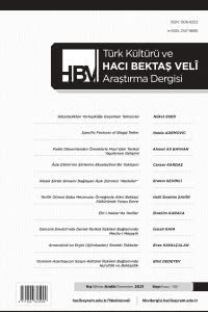PREŞOVA VE ÇEVRESİNDE OSMANLI KİTABELERİNE GENEL BİR BAKIŞ
Günümüz Sırbistan Cumhuriyeti sınırları içerisinde bulunan Preşova, 1912 yılına kadar Osmanlı idaresinde kalmıştır. Osmanlı idaresinden sonra Sırp işgaline uğrayan Preşova ve yöresi günümüz idari taksimatında Sırbistan’ın güneyinde çoğunlukla Arnavut nüfusun meskûn olduğu bölgeyi kapsayan Preşova Vasinin merkezi konumundadır. Preşova şehri ve ona bağlı Bilaç köyünde az sayıda Türk de yaşamaktadır. Osmanlı döneminden Balkan ülkelerinde kalmış olan maddi miras hakkında belli başlı çalışmalar yapılmıştır. 1970’li yıllardan sonra bu alandaki çalışmalar yoğunluk kazanmış olmakla birlikte Batı Balkanlar’a yönelik bu çalışmalarda daha çok Bosna, Sancak, Kosova, Makedonya’da bilinirliği daha fazla olan yerler üzerinde durulmuştur. Özellikle Yugoslavya’nın dağılma sürecinde Preşova’ya ilişkin kültürel çalışmaların yerel düzeyde kaldığını ileri sürmek için yeterli sayıda gerekçe vardır. Batı Balkanlar’ın 1990’lı yılların başından itibaren karşı karşıya kaldığı uzun süreli çatışmalar ve savaşlar eğitim, kültür ve bilim alanındaki gelişmeleri olumsuz anlamda etkilemiş ve etkilemeye devam etmektedir. Bu süreçte çok sayıda somut kültürel miras eseri zarar görmüş, tahrip olmuş ve hatta bir zaman var oldukları bile unutulmuştur. Günümüze kadar varlığını sürdürebilmiş az sayıda eserin de ömrünü uzatacak restorasyon çalışmaları sınırlıdır ve bu konuda yetkin bir kurumun eliyle yürütülmemektedir. Yerli halkın imece usulüyle hayatta tutmaya çalıştıkları bu eserlerin en azından envanterinin çıkarılması ve kayda geçirilmesi önemlidir. Bu anlamda yerel ölçekli yapılan bazı çalışmalar olmakla birlikte bu mirasın koruma altına alınmasını sağlayacak kurumları harekete geçirme konusunda yeterli olmamıştır. Bu çalışma ile Preşova ve yöresinde günümüze kadar ulaşabilmiş olan cami, tekke gibi ibadet ve zikir mekânları ile mezarlara ait kitabelerin ele alınması amaçlamaktadır. Bu çalışmada esas amaç Osmanlı döneminden kalma eserlerin tamamını tespit etmek olmayıp, şimdiye kadar üzerinde durulmamış olan bu kültürel mirasa işaret etmektir. Yoksa Osmanlı idaresi döneminden kalmış ve zaman içerisinde yok olmuş olan maddi miras yapılarının envanterinin çıkarılması daha geniş bir çalışmayı gerektirir. Bu çalışmada Preşova kasabası ve yöresinde Osmanlı idaresi döneminden kalmış olan yapılar üzerinde bulunan kitabe türleri ile şekil ve metin özelliklerine kısaca değinilmiştir
An Overview to the Ottoman Epitaphs Alphabet in Presheva Region
The city of Presheva, which is located within the borders of today’s Republic of Serbia, remained under Ottoman reign until 1912. Being invaded by Serbs after the Ottoman administration, Presheva and its region is situated at the centre of the Presheva Valley. By being located in the south of Serbia according to today’s administrative division, the region is vastly populated by Albanian residents. Besides the Albanian majority, the region is resided by a small number of Turks in Presheva and village of Bilaç. Major studies have been conducted on the Balkan countries heritage from the Ottoman period. Although the studies in this field have intensified after the 70s, the places that gained the focal point in the Western Balkans remained Bosnia, Sancak, Kosovo, and Macedonia. There is a sufficient support to claim that cultural studies on Presheva remained at the local level, especially during the dissolution of Yugoslavia. The long-term conflicts and wars that Western Balkans faced since the beginning of 90s have adversely affected and continue to affect the development in education, culture, and science. In this process, many tangible cultural heritage artefacts have been damaged, destroyed, and even forgotten. The restoration work that extends the life of a few number of works which have endured until today, is also limited and not performed by competent institutions. Even though the local people try to keep these works alive through voluntary initiative, it is essentially important for these works to be inventoried and recorded. There have been some local studies regarding this issue, but still not sufficient to drive the institutions at ensuring protection for this heritage. This study aims to deal with places of worship and dhikr, such as mosques, dervish lodges along with the inscriptions engraved in the tombs of Presheva and its region. It has also been intended to inform wider audience about the structures to which the inscriptions belong. The main purpose of this study is not only determining all the works from the Ottoman period, but also accentuating this cultural heritage, which has not been emphasized to this point. Moreover, making an inventory of the material heritage structures that remained from the Ottoman period and disappeared in time requires a broader study. Therefore, this study briefly mentions types and forms of inscriptions and text features placed on the buildings from the Ottoman period in the city of Presheva and its region.
___
- Ahmeti, Hatixhe. (2015). “Monumentet me mbishkrime osmane në pjesën e vjetër të qytetit të Preshevës dhe disa gurë të varreve”. Trashëgimia orientale-islame në Ballkan. Prishtinë: Instituti për shkenca humane “Ibni Sina”, 207-231.
- Agushi, Burbuqe A. (2009). Presheva me rrethinë në zhvillimin arkitektonik urbanistik. Prishtinë.
- Ayverdi, Eekrem Hakkı. (2000). Avrupa’da Osmanlı Mimari Eserleri-Yugoslavya (3. Kitap). İstanbul: İstanbul Fetih Cemiyeti.
- Ejupi, Arsim. (2015). Popullsia dhe vendbanimet shqiptare të Luginës së Preshevës, gjendja dhe rrjedhat bashkëkohore. Prishtinë.
- Islami, Hivzi ve Arsim Ejupi. (2015). Popullsia dhe vendbanimet shqiptare të Luginës së Preshevës. Prishtinë: ASHAK.
- Ismajli, Rexhep. (1970). “Mbi disa toponime në Serbi të jugut dhe në Maqedoni të veriut”. Gjurmime albanologjike, Nr. 1-2. Prishtinë: Instituti Albanologjik: 263-268.
- Kaleshi, Hasan. (2012). Dokumentet më të vjetra të vakëfeve në gjuhën arabe në Jugosllavi. Prishtinë.
- Kiel, Machiel. (2012). Arkitektura osmane në Shqipëri 1385-1912. İstanbul: IRCICA.
- Koller, Markus. (2012). “Shqiptarët në Perandorinë Osmane – një vështrim historik (shekujt XVII-XVII)”. Historia e shqiptarëve. Tiranë: Përpjekja.
- Meksi, Aleksander. (2007). “Probleme dhe aspekte të arkitekturës së xhamive në Shqipëri”. Qytetërimi Islam në Ballkan. İstanbul: IRCICA.
- Mujezinović, Mehmed. (1974). Islamska eipgrfafika Bosne i Hercegovine. Sarajevo: Veselin Maslesa.
- O’Conell Mark ve Raje Airey. (2009). The complete Encyclopedia of Signs and Symbols. London: Hermes House.
- Salihi, Xhemaledin. (2012). “Odat, Hanet, objektet dhe shtëpitë e vjetra në Preshevë me karakteristika kombëtare”. Erişim Tarihi: 07.09.2020.https:// www.preshevajone.com/hanet-cajtoret-objektet-dhe-shtepite-e-vjetra-ne- presheve/.
- Samsakçı, Mehmet. (2014). Kosova Kitabeleri. İstanbul: İstanbul Fetih Cemiyeti.
- Şemseddin Sami. (1308). “Preşova”. Kamusu’l-A’lâm, c. 2, Dersaadet: Mihrân, s. 699.
